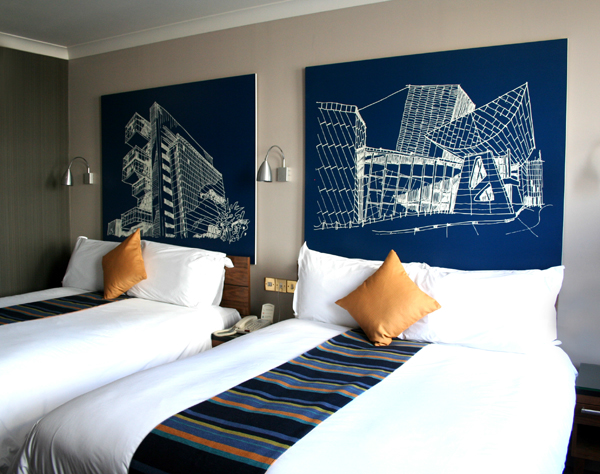
by Mary | Dec 6, 2015 | Design News, Graphic Design, Hospitality Design
Today, wall art and décor in interior design is significant; it has the interest of the guest and is taking a larger portion of the remodeling and new construction budget.
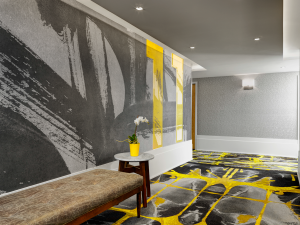
Corridor Photo from HotelArts. CA
This trend in part is based on the emerging custom wall paper and specialty graphics category that is merging wall finishes with wall art. Technology has made custom printing and custom manufacturing fueling creativity in hospitality interior design.
Wall art is seen in public areas but also in corridors, sleeping areas, and vanity areas. It can be also seen on advertising, marketing and TV’s within the guest suites.
What is considered viable wall art now?
Guests accept items hung on the wall or covering the wall to be viable “décor” when
- The subject matter reflects the local area in content or creator
- It is graphic design reflecting either property brand or current trends
- The “art” is recognizable as current style in trend based on their own experience of media and current events
- The technology or method of producing is current and of interest (i.e. custom wall paper or oversized graphics)
How does an owner create a wall art program?
- Most interior design firms now provide art selection and art design services.
- Local graphic designers and art galleries are prepared to offer custom programs.
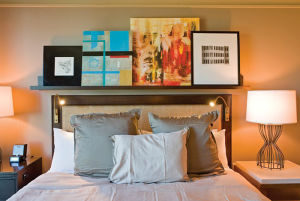
Image from The Guardian Pe. CA
What is the ROI of a wall art program?
A wall art program can promote and connect with regional organizations in either content or reference. This connection exposes the property to a non-user audience, promoting future business.
A wall art program can be copyrighted and be considered an asset of the property, being used in marketing, advertising and social media. Reprints can become “products for sale” through the property’s channels.
When a hospitality property can further describe their brand through visuals, that can also be considered “art”, it creates emotional and lasting impressions with their customers.
Wall art in hospitality is one of many ways properties are trying to be personal, expressing their values and interests. Art makes personal connections, a valuable asset in building customer loyalty.
Updating an interior by changing wall art and décor is far less disruptive than changing an architectural finish. It allows owners to “update” without upsetting room rentals.

by Mary | Dec 6, 2015 | Design News, Hospitality Design
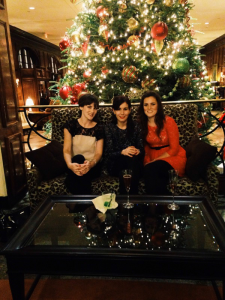 Hospitality properties have guests who spend the holidays with them; sometimes by choice and sometimes not, sometimes in small groups and sometimes not. It is a time for properties to show what they are made of and fill in the gaps for holiday guests.
Hospitality properties have guests who spend the holidays with them; sometimes by choice and sometimes not, sometimes in small groups and sometimes not. It is a time for properties to show what they are made of and fill in the gaps for holiday guests.
During the winter holiday, staff is called on to be even more personal and intentional. These holidays show how well a properties staff is hired, trained and managed to support an experience that is worthy to be considered a celebratory time. A time when emotional connections can be made.
Guests who decide to celebrate the season with you want the property to give them the holiday they couldn’t have at their own home. Decorations, uniforms, sentiment, menu items, activities, the works!
It may be less important to recreate their particular traditions than it is have a hotel tradition. Properties and resorts who create a branded event and all the anticipation building up to it, have set the stage to a wonderful memory. But an event alone won’t be enough.
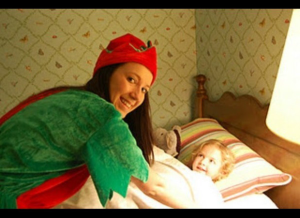
Elf – Style Sleep Tight Goodnight
- It may be guests with little to no family decide to celebrate with you. That means the staff has to make a personal connection with guests, recreating family and intimacy.
- It may be guests who are taking the whole family to your site expect you to recreate “home”. This group needs greater flexibility in food service, identified hosts and personalities that can help them through their reunions.
- It all cases guests are ready to be surprised by joy, generosity and the ability to share.

Holiday Surprises for Customers of WestJet
An example of the type of success that can be had is described by blogger Alexander Kellerman who wished this celebration happened in a hotel verses in an airport-http://www.hotelierinc.com/is-the-hotel-industry-losing-its-hospitality/#more-1340
There is no bluffing during the holidays. The guests have high expectations and vulnerabilities. Meet those needs and you have a guest forever.
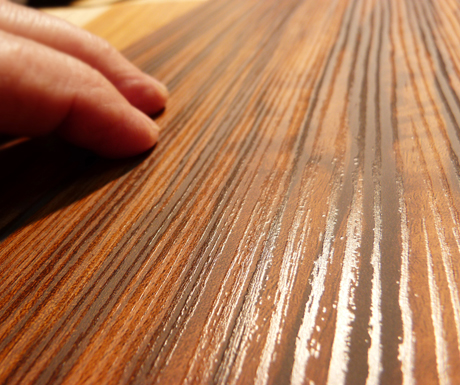
by Mary | Oct 13, 2015 | Hospitality Design, Interior Design, Procurement and Purchasing, Project Management
With the increase of new hotel and resort projects, as well as robust remodeling, owners and construction project managers are re-examining how they fulfill the millwork and casegood category of their building projects.
r.o.i. Design describes millwork as casegoods that are fixed to the architecture. Casegoods (typically described in the furniture category) and millwork are amortized differently on the balance sheet and quite often supplied by different sources. This area of procurement is a challenge but also an opportunity.
Aside: The debate about buying US or non-US continues, but the more foreign manufacturers merge their offering with state side distribution, the point of manufacturing is becoming less of a political, economic issue. We all need each other, globally to make our businesses work, within reason. Logistics and the chain of ownership continues to be the defining component to value and control.
r.o.i. Design can contribute to this dialogue with these observations:
- Understanding: When the customer understands that the total cost of a product includes, freight, handling, staging and delivery-the criteria may change. The age old mantra, “you can have 2 of the 3 – 1. design, 2. price or 3. schedule” still holds true.
- Flexibility: And when the project team is willing to look at qualified suppliers outside their list of typical vendors, value can be realized.
- Cost Analysis: Overseas products may show up with a reduced unit price, but the cost and risk to get those products to the site, as designed and on time is not always as manageable. We see this situation being improved incrementally and by situation, but as of October 2015, we don’t make price or lead time promises on overseas product without considerable confirmation and agreement.
- New Materials and Technology: While process and manufacturing styles for US manufacturers are consistent, their emerging ability to use new materials and technology are offering a value that competes with the “all in costs” of overseas manufactures.
- Design-Assist: When project budgeting can take advantage of qualified suppliers, early in the process, value is realized. Sharing the designing of products with the makers of the products only makes sense to our customers.

Textured Melamine
New Materials
In the last few years, r.o.i. Design has specified “new materials” with great success.
- Textured melamine panel products offer a huge advantage for larger projects.
- The big names in laminate (Formica, Wilsonart, Pionite and Nevamar) have done there homework and laminate, an affordable option, is becoming a more viable option to wood or stone in today’s designs.
- And the combined use of solid surface veneer with laminates has created options for look and feel not available even a year ago.
- Upholstered casegoods are a viable option. Technology and design has created a category of fabric that defies wear, responds to robust cleaning and is easily replaceable. Fabrics are merging with hard surface options.
r.o.i. Design has it roots in manufacturing for hospitality and while we only have a sample shop today, our interest, relationships and experience in casegoods and millwork continue to bring value to our customers.
We negotiate with our customers and their contractors to determine how we best can bring value to their millwork and casegood procurement.
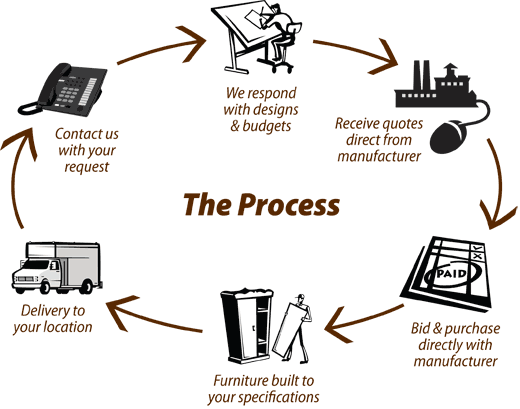
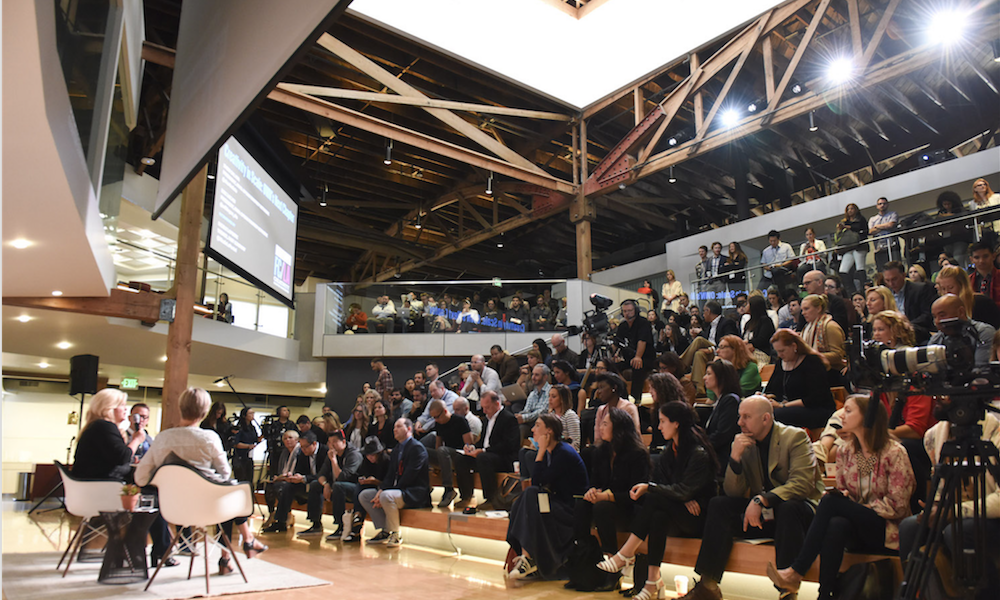
by Mary | Oct 13, 2015 | Hospitality Design, Meeting and Conference
Businesses and associations are starting to promote business gatherings again. The economic hardship of the last 5-8 years drastically impacted that business for properties; now groups are reconsidering the away-training , coincidentally, there are some requests being made of facility design and service from those groups.
Properties have analyzed how many unique guests visited their property in a year, and they know it is possible that more people experience a hotel or resort for a meeting than those whose who come for more than 2 day stay. The meeting and conference business fuels the social business and vise-versa. Properties are more interested than ever to meet new people, offer them hospitality or a day, in hopes they will return for more.
r.o.i. Design has been responding to properties changing needs for meeting and conference, and we share here the trends we see.
In general, the trend is toward “conversation” and “community” supported by technology.
Properties group sales staff are working with a wide variety of “hosts”, not just the millennial.
The decision maker varies in age, experience, role and most importantly by requests. There is not one customer to please. Properties are becoming more and more agile in their response to the meeting and conference business. That means flexibility in furnishings, meals, technology and overall schedule.
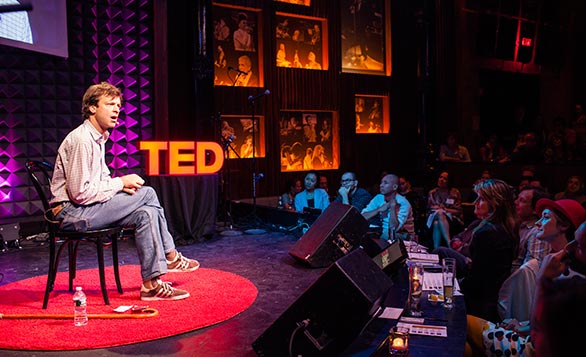
Joshua Prager at TED@NewYork talent search. June 7, 2012. New York, NY. Photo: Ryan Lash
Seating options are no longer limited to banquet, training and theater style layouts.
The incoming group is looking for a wider variety of seating options, and not just for the meeting but for break out and meal arrangements as well. r.o.i. Design has studied this and found a correlation between this expectation and the customers current experience of other environments, including but not limited to, coffee lounges, retail spaces, a recent local “Ted Talk”, church assemblies, university classrooms (virtual and brick) and their own homes. The challenge is to make one group of inventoried furniture morph into a variety of experiences. Requests for accent pillows, more side tables or even lamps have started to show up.
Technology not only means that the participant has to get online.
The presenter needs to have clear access to the internet and an easy way to show their presentation. Offering a plug and play that is effortless for the presenter and allows participants to use their lap tops to also dial into the presentation is going to be the norm.
Lighting and lighting controls need to be controlled by the guest.
If a group is looking at their lap tops to get a better look at the shared presentation they may need a dimmer setting of overhead lights, or if the audience has to be woken up after lunch the present may want to increase light levels, or if the ambient light is changing from daylight to evening, the group needs to have control.
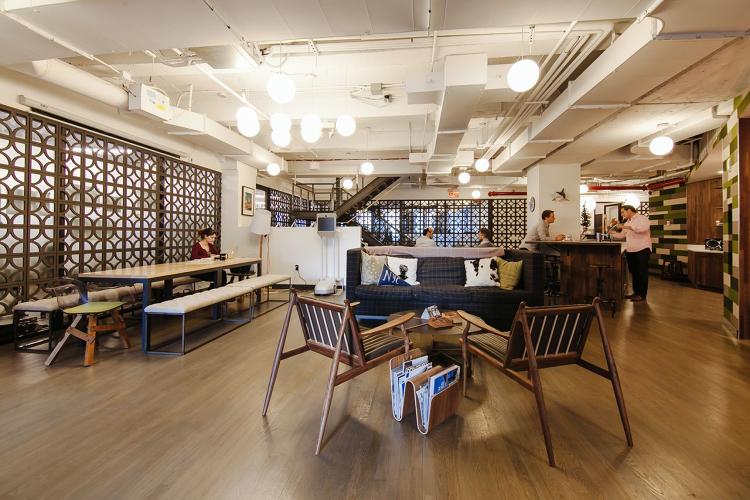
Break Out Spaces with Options
Gluten free, vegetarian, Indian vegetarian, vegan…
The percentage of special meal requests is increasing. The ill fated salad bar is dead but properties are figuring out how to create a manageable “buffet” that each guest can customize without the kitchen having to go through cart wheels to feed the diverse palette. The most innovative are including the guest in their food preparation and providing a lot of options for seating within a proximity of the whole.
Properties are discovering that some of their spaces that may not have been previously considered as viable “meeting and conference” assets to be very appealing to customers.
r.o.i. Design acknowledges that the most successful one day hospitality experiences are the result of an innovative staff, an engaged host, an informed speaker and a facility inventoried with all the items needed to encourage a unique experience.
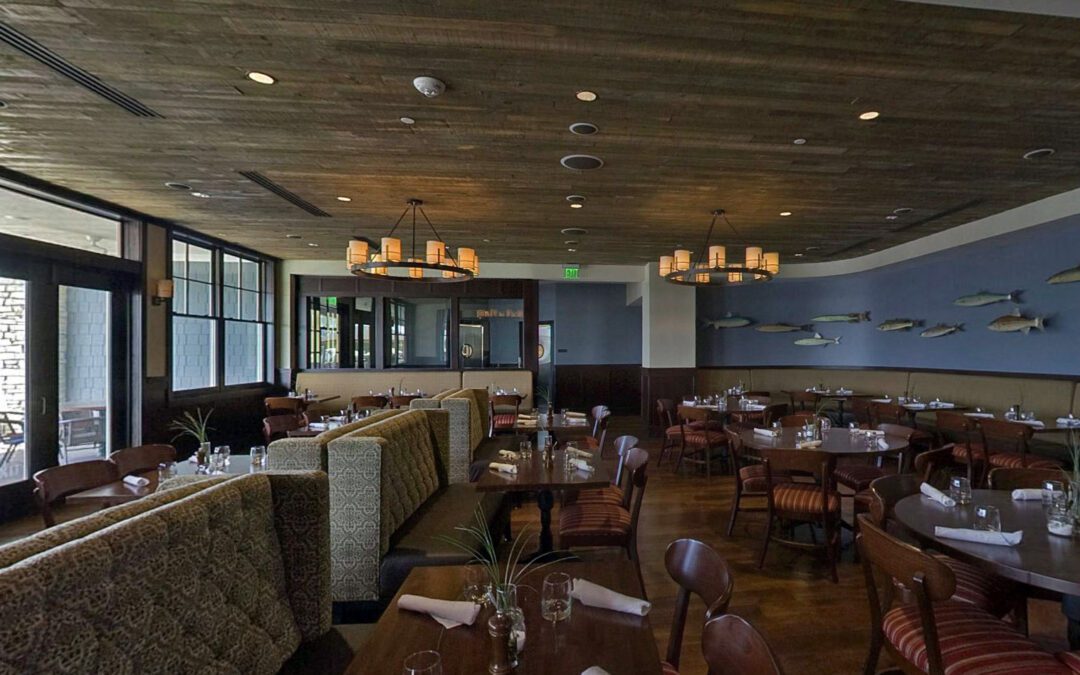
by Mary | Sep 6, 2015 | Construction, Hospitality Design, Interior Design, Restaurant Design, Retail Design
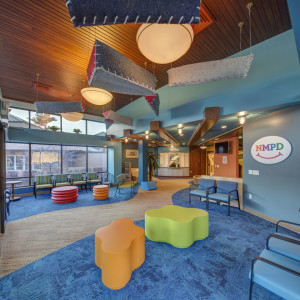
Northern Michigan Pediatric Dentistry. A design build team- r.o.i. Design was the interior designer.
Who is the design team?
The building architect, interior designer, site engineer, landscape architect, structural engineer, civil engineer, casegood designer, furniture designer, and art consultant all make up the design team.
Construction managers are dealing with a variety of team types:
One Stop Shopping
Large architect and engineering firms who offer “one stop shopping”, everything in one company, linear accountability. Convenient but not always transparent. When a design team has a bundle of work with a contractor, it is easier for the GM to negotiate changes since they are funneling a quantity of work to a firm.
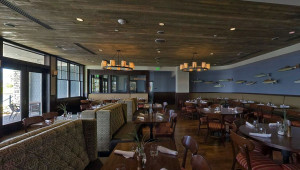
The Inn at Harbor Shores, r.o.i. Design was recommended by contractor as an industry specialist.
Industry Specialist
A key player (designer or architect) who offers unique experience in a construction type: charter schools, national retail chains, senior care, mid-scale hotels, higher education, specialty medical, etc. , who recommends a group of independents they or the contractor manages to fill out the roster of all the professional design requirements.
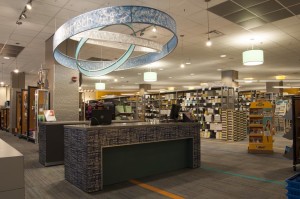
GVSU Laker Store, a customer directed design team. r.o.i. Design worked as planners and interior designers.
Customer Team
When there are pre-existing relationships that have to be managed and the contractor works with the customer to fill out the professional needs of the project with a variety of firms.
Design-Build
The “design-build” team is assembled by the contractor and the customer directs all design criteria to the contractor who then works with their choice of professionals to support planning, produce design, architecture, engineering and all it’s documentation.
So what is the ideal “design team”? It’s the one that works best for the project.
Experienced construction professionals understand that they can’t have just one process that will deliver the design on all their projects (unless the contractor only works with one building type). Experienced construction professionals know they have to have a variety of firms in their contact list and stay informed of changes in those firms, understanding their emerging strengths and successes on new projects.
##
r.o.i. Design works on several teams and team types. We understand the “R’s”: rates, relationships and relevance. We see successful design companies prosper when they can collaborate and adjust to changing criteria. We also see the importance of the construction manager who realizes the need for customers to be connected to the design process and their designers, and still be sure their budget and timeline are prioritized.

by Mary | Sep 6, 2015 | Construction, Design News, Designing Public Areas, Hospitality Design, Retail Design
Recently, r.o.i. Design was at a bid opening and after hearing the bids for Division 09, it was clear to all that something was “up”. We all are seeing a steady increase in the percentage of costs spent in finishes in projects.
r.o.i. Design has been able to balance budgets by applying specialty finishes with discretion in key areas and working with contractors on the design as a whole, before a project goes to bid. Managing customer expectations at the design phase is key in order to deliver the interior the customer requires.
Some of the areas to watch for creeping costs include:
Hard surface flooring
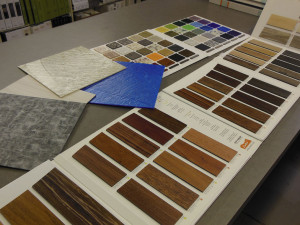
LVT is available in a wide selection of colors and patterns, including those that mimic wood and stone.
The old stand by – vinyl composite tile (VCT) – which is affordable at install, but adds cost
every year in maintenance, is loosing ground to other composites that don’t have that ongoing expense. There are VET (vinyl enhanced tiles) and LVT (luxury vinyl tiles) whose retail square foot costs are a minimum of $1 more than VCT.
A larger portion of the flooring in projects are receiving hard surfaces verses carpet.
The love for finished concrete isn’t necessarily a budget saver and it’s popularity has demanded more skilled trades in adapting concrete in order to be considered a finished floor.
Wall panels and specialty wall treatments
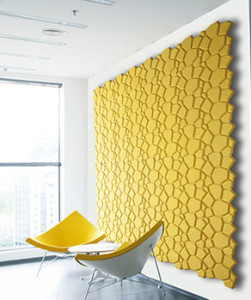
Molded cork wall coverings by Murrato
Wall covering manufacturers have been busy coming up with new materials and designs that are gaining interest. r.o.i. Design doesn’t believe we will ever see projects where 100% of the walls are covered with wall covering as was prevalent in the 90’s, but do see a percentage of the walls being given “special” treatment.
Custom wall covering and panel products are becoming more affordable allowing customers to create “branded” and proprietary looks to their interiors. Part of that customization means the finish category is fulfilling more of the signage requirements of a building.
Ceilings
 Changes in technology have advanced product design and improved product performance. But the first wave of those innovations come at a higher price. The cycle of new product introduction is more robust, and increased competition will start to impact costs on trendy finishes in a positive direction.
Changes in technology have advanced product design and improved product performance. But the first wave of those innovations come at a higher price. The cycle of new product introduction is more robust, and increased competition will start to impact costs on trendy finishes in a positive direction.



















